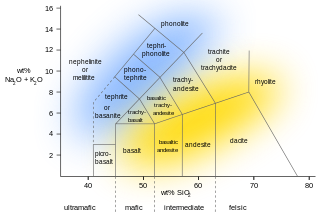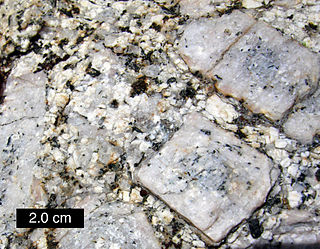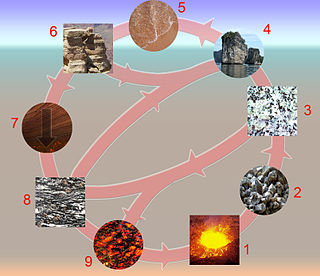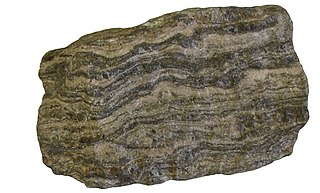
Feldspar is a group of rock-forming aluminium tectosilicate minerals, also containing other cations such as sodium, calcium, potassium, or barium. The most common members of the feldspar group are the plagioclase (sodium-calcium) feldspars and the alkali (potassium-sodium) feldspars. Feldspars make up about 60% of the Earth's crust, and 41% of the Earth's continental crust by weight.

A pegmatite is an igneous rock showing a very coarse texture, with large interlocking crystals usually greater in size than 1 cm (0.4 in) and sometimes greater than 1 meter (3 ft). Most pegmatites are composed of quartz, feldspar, and mica, having a similar silicic composition to granite. However, rarer intermediate composition and mafic pegmatites are known.

Metamorphic rocks arise from the transformation of existing rock to new types of rock in a process called metamorphism. The original rock (protolith) is subjected to temperatures greater than 150 to 200 °C and, often, elevated pressure of 100 megapascals (1,000 bar) or more, causing profound physical or chemical changes. During this process, the rock remains mostly in the solid state, but gradually recrystallizes to a new texture or mineral composition. The protolith may be an igneous, sedimentary, or existing metamorphic rock.

Trachyte is an extrusive igneous rock composed mostly of alkali feldspar. It is usually light-colored and aphanitic (fine-grained), with minor amounts of mafic minerals, and is formed by the rapid cooling of lava enriched with silica and alkali metals. It is the volcanic equivalent of syenite.

Extrusive rock refers to the mode of igneous volcanic rock formation in which hot magma from inside the Earth flows out (extrudes) onto the surface as lava or explodes violently into the atmosphere to fall back as pyroclastics or tuff. In contrast, intrusive rock refers to rocks formed by magma which cools below the surface.

Amphibolite is a metamorphic rock that contains amphibole, especially hornblende and actinolite, as well as plagioclase feldspar, but with little or no quartz. It is typically dark-colored and dense, with a weakly foliated or schistose (flaky) structure. The small flakes of black and white in the rock often give it a salt-and-pepper appearance.

Porphyritic is an adjective used in geology to describe igneous rocks with a distinct difference in the size of mineral crystals, with the larger crystals known as phenocrysts. Both extrusive and intrusive rocks can be porphyritic, meaning all types of igneous rocks can display some degree of porphyritic texture. Most porphyritic rocks have bimodal size ranges, meaning the rock is composed of two distinct sizes of crystal.

Volcanic rock is a rock formed from lava erupted from a volcano. Like all rock types, the concept of volcanic rock is artificial, and in nature volcanic rocks grade into hypabyssal and metamorphic rocks and constitute an important element of some sediments and sedimentary rocks. For these reasons, in geology, volcanics and shallow hypabyssal rocks are not always treated as distinct. In the context of Precambrian shield geology, the term "volcanic" is often applied to what are strictly metavolcanic rocks. Volcanic rocks and sediment that form from magma erupted into the air are called "pyroclastics," and these are also technically sedimentary rocks.

The lithology of a rock unit is a description of its physical characteristics visible at outcrop, in hand or core samples, or with low magnification microscopy. Physical characteristics include colour, texture, grain size, and composition. Lithology may refer to either a detailed description of these characteristics, or a summary of the gross physical character of a rock. Examples of lithologies in the second sense include sandstone, slate, basalt, or limestone.

The matrix or groundmass of a rock is the finer-grained mass of material in which larger grains, crystals, or clasts are embedded.

A phenocryst is an early forming, relatively large and usually conspicuous crystal distinctly larger than the grains of the rock groundmass of an igneous rock. Such rocks that have a distinct difference in the size of the crystals are called porphyries, and the adjective porphyritic is used to describe them. Phenocrysts often have euhedral forms, either due to early growth within a magma, or by post-emplacement recrystallization. Normally the term phenocryst is not used unless the crystals are directly observable, which is sometimes stated as greater than .5 millimeter in diameter. Phenocrysts below this level, but still larger than the groundmass crystals, are termed microphenocrysts. Very large phenocrysts are termed megaphenocrysts. Some rocks contain both microphenocrysts and megaphenocrysts. In metamorphic rocks, crystals similar to phenocrysts are called porphyroblasts.

Intrusive rock is formed when magma penetrates existing rock, crystallizes, and solidifies underground to form intrusions, such as batholiths, dikes, sills, laccoliths, and volcanic necks.

The rock cycle is a basic concept in geology that describes transitions through geologic time among the three main rock types: sedimentary, metamorphic, and igneous. Each rock type is altered when it is forced out of its equilibrium conditions. For example, an igneous rock such as basalt may break down and dissolve when exposed to the atmosphere, or melt as it is subducted under a continent. Due to the driving forces of the rock cycle, plate tectonics and the water cycle, rocks do not remain in equilibrium and change as they encounter new environments. The rock cycle explains how the three rock types are related to each other, and how processes change from one type to another over time. This cyclical aspect makes rock change a geologic cycle and, on planets containing life, a biogeochemical cycle.

A porphyroblast is a large mineral crystal in a metamorphic rock which has grown within the finer grained matrix. Porphyroblasts are commonly euhedral crystals, but can also be partly to completely irregular in shape.

Foliation in geology refers to repetitive layering in metamorphic rocks. Each layer can be as thin as a sheet of paper, or over a meter in thickness. The word comes from the Latin folium, meaning "leaf", and refers to the sheet-like planar structure. It is caused by shearing forces, or differential pressure. The layers form parallel to the direction of the shear, or perpendicular to the direction of higher pressure. Nonfoliated metamorphic rocks are typically formed in the absence of significant differential pressure or shear. Foliation is common in rocks affected by the regional metamorphic compression typical of areas of mountain belt formation.

A porphyroclast is a clast or mineral fragment in a metamorphic rock, surrounded by a groundmass of finer grained crystals. Porphyroclasts are fragments of the original rock before dynamic recrystallisation or cataclasis produced the groundmass. This means they are older than the groundmass. They were stronger pieces of the original rock, that could not as easily deform and were therefore not or hardly affected by recrystallisation. They may have been phenocrysts or porphyroblasts in the original rock.

Augen are large, lenticular eye-shaped mineral grains or mineral aggregates visible in some foliated metamorphic rocks. In cross section they have the shape of an eye.

Igneous textures include the rock textures occurring in igneous rocks. Igneous textures are used by geologists in determining the mode of origin of igneous rocks and are used in rock classification. The six main types of textures are phaneritic, aphanitic, porphyritic, glassy, pyroclastic, and pegmatitic.
This glossary of geology is a list of definitions of terms and concepts relevant to geology, its sub-disciplines, and related fields. For other terms related to the Earth sciences, see Glossary of geography terms.




















